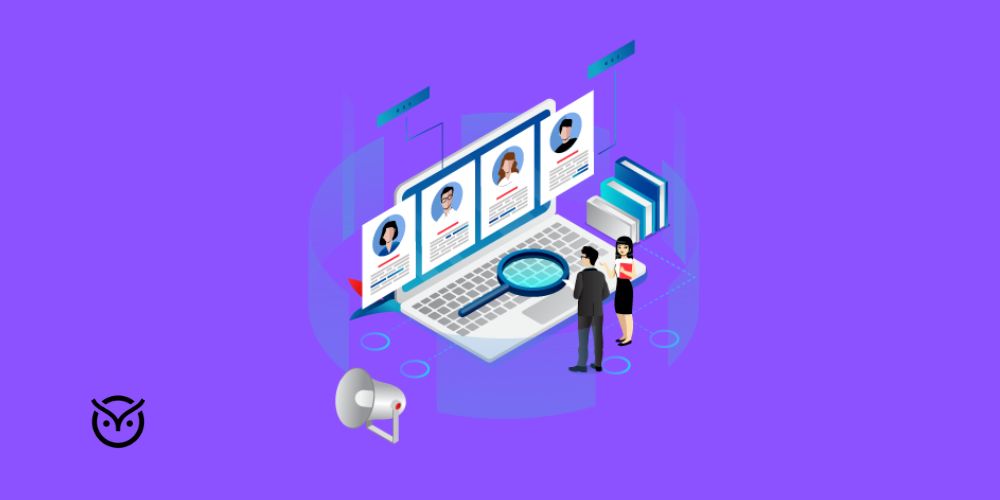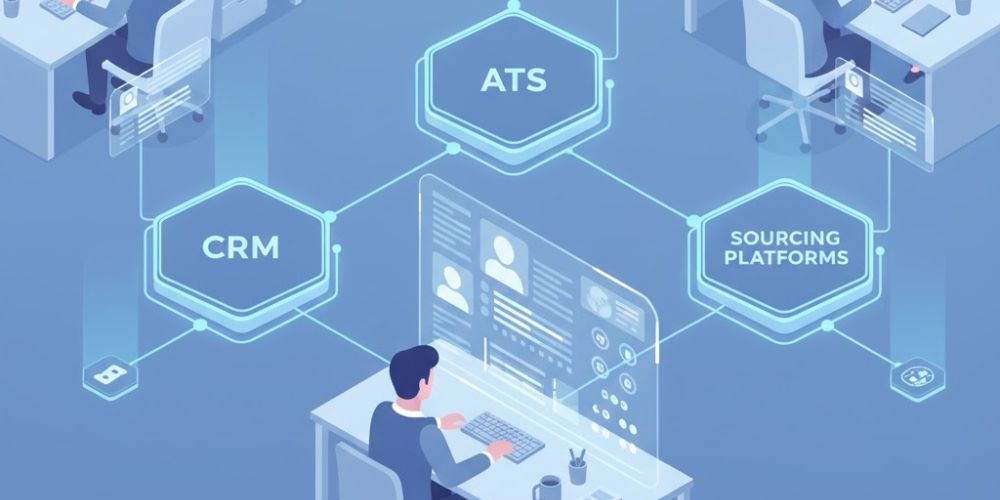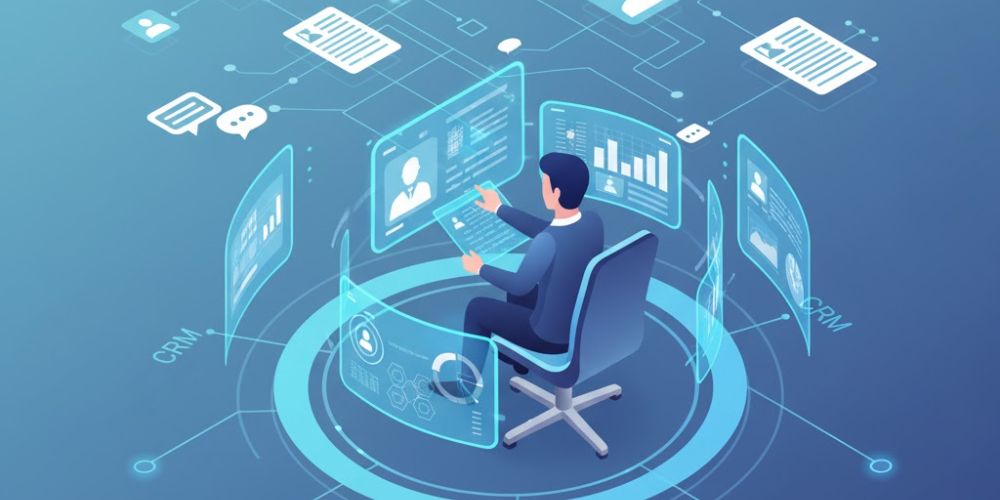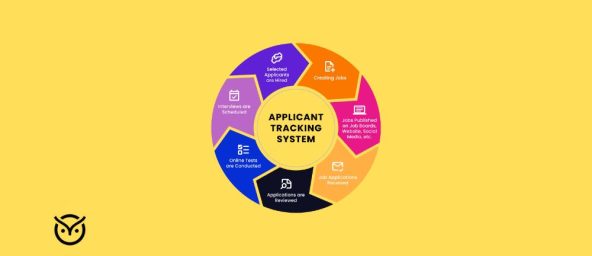
TL;DR
- Recruitment teams are shifting toward integrated recruitment ecosystems
- An ecosystem approach empowers powerful strategies
- Key components: a CRM to engage passive talent, an ATS to manage workflows, etc.
- Benefits include faster time-to-hire, reduced cost per hire, and more
Hiring has never been more complex. Many organizations deploy separate tools for applicant tracking, candidate relationship management and talent sourcing—only to still struggle with fragmented data, slow processes and disconnected experiences. In this scenario, integrated recruitment systems offer a way out, aligning CRM, ATS and sourcing tools into one seamless ecosystem.
When everything talks to each other, recruiters can execute effective candidate sourcing without premium tools, nurture passive talent via master passive candidate sourcing with Vettio tech, and ultimately deliver effective recruitment plan strategies for HR tech with confidence.
What Is a Recruitment Ecosystem?

A recruitment ecosystem is an interconnected system of tools and workflows designed to support every stage of talent acquisition—sourcing, screening, engagement, hiring and onboarding. At its core, the ecosystem combines three major pillars:
- CRM (Candidate Relationship Management) – Engages and nurtures talent before they apply.
- ATS (Applicant Tracking System) – Manages active applications, interview schedules and hires.
- Sourcing tools and channels – Extend reach beyond job boards via social media, internal mobility, university hiring and passive candidate pipelines.
In an ecosystem approach, these components don’t operate in isolation: they exchange data, feed insights and create a unified view of both current and potential candidates. This integration underpins statements like “Sourcing vs Recruiting: Key Differences Explained”—where sourcing builds pools, recruiting progresses them, and the ecosystem lets them merge fluidly.
Why Recruiters Need Integrated Ecosystems

Here’s why a unified, integrated recruitment ecosystem matters more than ever:
- Market pressure and scale – The global recruiting market is projected to hit around USD 642 billion in 2025, growing at a CAGR of 7.56% through 2030. Organisations must scale sourcing and hiring efficiently.
- Tech adoption – 70% of large companies use an ATS, and 75% of recruiters say ATS has improved hiring outcomes. Integration of CRM, ATS and sourcing is the next frontier.
- Performance gains – Companies that properly integrate their HR tech stack report up to 30% faster hiring, 25% lower cost per hire, and 20% better retention.
- Sourcing sophistication – Modern strategies like “Social Media Sourcing for Smarter Talent Assessment”, “Top Free Sourcing Tools to Boost Recruiting” and “Innovative Ways to Source Candidates Beyond Boards” demand a system where data flows seamlessly.
- Competitive edge – Recruiters who harness effective candidate sourcing tips for recruiters” and effective talent acquisition strategies with Vettio within an integrated ecosystem can move faster and smarter.
Key Components of a Recruitment Ecosystem

To build an effective ecosystem, focus on these key modules—each of which supports integrated recruitment in meaningful ways:
1. Candidate Relationship Management (CRM)
- Purpose: build talent pools, nurture passive candidates and keep leads warm.
- Enables: Effective passive candidate sourcing, continuous engagement and pipeline readiness instead of cold job posts.
- Tip: Tag and segment talent by skills, interests and career ambitions; send tailored content rather than generic blasts.
2. Applicant Tracking System (ATS)
- Purpose: track candidates through application, screening, hiring and onboarding.
- Stat: 93% of recruitment professionals use an ATS to streamline hiring.
- Why it matters: With integration, ATS data feeds back into CRM and sourcing tools—for example, showing which sourcing channels yield the best hires.
3. Sourcing Tools & Channels
- Purpose: find talent beyond job boards—via social media, university hiring, internal mobility and AI-powered search.
- Supports: Innovative ways to source candidates beyond boards, boost Recruiting Efficiency with AI-powered sourcing.
- Example: Use social listening to identify passive talent, then feed those profiles into your CRM so you can engage before the job ever opens.
4. Analytics & Reporting
- Purpose: take data from CRM, ATS and sourcing tools, then generate insights: which channels deliver best quality, time-to-hire, cost-per-hire, and diversity metrics.
- Integration benefit: when CRM + ATS + sourcing data flows together, you can run effective candidate sourcing for better talent assessment”—not just guesswork.
5. Workflow Automation & Integration Layer
- Purpose: connect systems (CRM to ATS, sourcing tools to CRM) so there’s no manual hand-off or data duplication.
- Example: When a sourced lead converts to candidate status, the ATS automatically triggers engagement steps, scheduling, assessments and analytics reports.
- Supports: “Effective Recruitment Plan Strategies for HR Tech”.
6. Candidate Experience & Engagement Tools
- Purpose: ensure candidates (passive and active) feel engaged and informed. Integrated systems send automated updates, personalized content, and streamline communication.
- Benefit: enhances employer brand and supports “Optimize Talent Acquisition: Internal vs External Recruitment” by treating all candidate sources with equal care.
Benefits of Integrated Recruitment Systems

When you bring your tools together into a single integrated recruitment ecosystem, the results speak for themselves. Let’s unpack the key advantages:
1. Unified Data, Smarter Decisions
With every candidate interaction recorded in one place—whether sourced from social media, job boards, or referrals—recruiters gain a 360° view of talent. This helps teams execute effective candidate sourcing for better talent assessment instead of guessing which channels deliver results.
Integrated analytics highlight which sourcing channels yield top performers and which need fine-tuning, empowering effective sourcing recruiter strategies for talent acquisition.
2. Faster Hiring, Lower Costs
According to Glassdoor’s research, the average time-to-hire across industries is 23.8 days. Integrated ecosystems can shorten that dramatically by eliminating manual data transfers between systems.
For example, once a candidate sourced via social media sourcing for smarter talent assessment is added to the CRM, their details automatically sync with the ATS—cutting days off the hiring process and enabling effective candidate sourcing for hiring success.
3. Stronger Candidate Relationships
Recruiters can now nurture talent long before job openings arise. A connected CRM–ATS workflow supports effective passive candidate sourcing and ongoing engagement through email campaigns, personalized outreach, and automated follow-ups.
4. Enhanced Collaboration & Visibility
Hiring managers, recruiters, and HR teams can view candidate progress in real time. This shared visibility helps teams boost recruiting efficiency with AI-powered sourcing and ensure that effective Internal and external recruitment strategies align with business goals.
5. Improved Diversity and Inclusion
Integrating sourcing tools allows companies to boost talent sourcing with diversity and inclusion initiatives. When data flows across platforms, recruiters can monitor demographic balance, identify unconscious bias, and implement fair hiring practices.
6. Scalable Global Hiring
For organizations expanding internationally, an ecosystem that supports effective global talent acquisition strategies for HR is a game-changer. Recruiters can handle multi-region hiring, time-zone differences, and multilingual candidate pipelines from one system.
7. Enhanced Quality of Hire
By combining candidate engagement (CRM) with sourcing intelligence and assessment data, teams can execute effective university hiring with advanced assessments and boost talent acquisition with smart recruitment tips.
Common Integration Challenges

Building a unified, integrated recruitment ecosystem isn’t plug-and-play. Here are common roadblocks and how to overcome them:
1. Data Silos & Compatibility Issues
Different systems store data in different formats. Integrating sourcing tools, CRM, and ATS often requires middleware or APIs. Without them, teams risk duplicate or incomplete records—hindering understanding candidate sources in talent assessment.
Fix: Choose solutions with open APIs and pre-built connectors, like Vettio.
2. Change Management Resistance
Recruiters used to traditional workflows may hesitate to adopt new systems. When integrations roll out without adequate training, adoption stalls.
Fix: Start with pilot teams and provide step-by-step learning paths that focus on outcomes—like reducing time-to-hire or improving effective talent acquisition strategies.
3. Security and Compliance Concerns
Multiple tools increase data exposure risks. HR teams handle sensitive candidate information, so integration must comply with GDPR and other local data-protection laws.
Fix: Partner with vendors that use encrypted data storage and SOC 2-compliant infrastructure. Data audits should be routine, ensuring effective recruitment plan strategies for HR tech remain safe and compliant.
4. Cost and Complexity
Building a customized ecosystem can be costly, especially for small or medium-sized businesses. However, avoiding integration can be more expensive in the long run due to inefficiency and lost candidates.
Fix: Leverage modular systems—start with core integrations (CRM + ATS) and scale to sourcing tools later. This staged approach allows even smaller teams to adopt effective candidate sourcing without premium tools affordably.
5. Lack of Unified Metrics
When each tool measures performance differently, recruiters can’t tell which source performs best.
Fix: Standardize KPIs across your stack—time-to-hire, cost-per-hire, source quality, and candidate satisfaction—so data from effective candidate sourcing for better talent assessment can feed actionable insights into one dashboard.
Conclusion
Recruitment is no longer just about filling roles—it’s about designing connected, data-driven ecosystems that evolve with your workforce. Integrating CRM, ATS, and sourcing tools gives recruiters the power to identify, engage, and retain the right talent faster.
As work models shift and competition for skilled talent intensifies, adopting an integrated recruitment approach with platforms like Vettio can transform your hiring process—from reactive to predictive. The message is clear: unify your tools, empower your teams, and let the ecosystem work for you.




